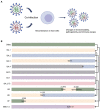The effects of amino acid substitution of spike protein and genomic recombination on the evolution of SARS-CoV-2
- PMID: 37560529
- PMCID: PMC10409611
- DOI: 10.3389/fmicb.2023.1228128
The effects of amino acid substitution of spike protein and genomic recombination on the evolution of SARS-CoV-2
Abstract
Over three years' pandemic of 2019 novel coronavirus disease (COVID-19), multiple variants and novel subvariants have emerged successively, outcompeted earlier variants and become predominant. The sequential emergence of variants reflects the evolutionary process of mutation-selection-adaption of severe acute respiratory syndrome coronavirus 2 (SARS-CoV-2). Amino acid substitution/insertion/deletion in the spike protein causes altered viral antigenicity, transmissibility, and pathogenicity of SARS-CoV-2. Early in the pandemic, D614G mutation conferred virus with advantages over previous variants and increased transmissibility, and it also laid a conservative background for subsequent substantial mutations. The role of genomic recombination in the evolution of SARS-CoV-2 raised increasing concern with the occurrence of novel recombinants such as Deltacron, XBB.1.5, XBB.1.9.1, and XBB.1.16 in the late phase of pandemic. Co-circulation of different variants and co-infection in immunocompromised patients accelerate the emergence of recombinants. Surveillance for SARS-CoV-2 genomic variations, particularly spike protein mutation and recombination, is essential to identify ongoing changes in the viral genome and antigenic epitopes and thus leads to the development of new vaccine strategies and interventions.
Keywords: Omicron; SARS-CoV-2; amino acid substitution; evolution; recombination; spike protein.
Copyright © 2023 Fang, Xu, Zhao, Fan, Shen, Liu and Cao.
Conflict of interest statement
The authors declare that the research was conducted in the absence of any commercial or financial relationships that could be construed as a potential conflict of interest.
Figures





Similar articles
-
Tracking SARS-CoV-2 Omicron diverse spike gene mutations identifies multiple inter-variant recombination events.Signal Transduct Target Ther. 2022 Apr 26;7(1):138. doi: 10.1038/s41392-022-00992-2. Signal Transduct Target Ther. 2022. PMID: 35474215 Free PMC article.
-
Molecular Evolutionary Analyses of the Spike Protein Gene and Spike Protein in the SARS-CoV-2 Omicron Subvariants.Microorganisms. 2023 Sep 18;11(9):2336. doi: 10.3390/microorganisms11092336. Microorganisms. 2023. PMID: 37764181 Free PMC article.
-
Genomic epidemiology and evolutionary analysis during XBB.1.16-predominant periods of SARS-CoV-2 omicron variant in Bangkok, Thailand: December 2022-August 2023.Sci Rep. 2024 Jan 5;14(1):645. doi: 10.1038/s41598-023-50856-0. Sci Rep. 2024. PMID: 38182705 Free PMC article.
-
The nuts and bolts of recombination in the generation of SARS-CoV-2 variants; from XA to XBB.Lett Appl Microbiol. 2024 Aug 5;77(8):ovae074. doi: 10.1093/lambio/ovae074. Lett Appl Microbiol. 2024. PMID: 39081071 Review.
-
Research progress in spike mutations of SARS-CoV-2 variants and vaccine development.Med Res Rev. 2023 Jul;43(4):932-971. doi: 10.1002/med.21941. Epub 2023 Mar 16. Med Res Rev. 2023. PMID: 36929527 Review.
Cited by
-
The immunological impact of revaccination in a hybrid-immune world.Front Immunol. 2025 Jun 9;16:1588259. doi: 10.3389/fimmu.2025.1588259. eCollection 2025. Front Immunol. 2025. PMID: 40552302 Free PMC article. Review.
-
SARS-CoV-2 biological clones are genetically heterogeneous and include clade-discordant residues.J Virol. 2025 May 20;99(5):e0225024. doi: 10.1128/jvi.02250-24. Epub 2025 Apr 24. J Virol. 2025. PMID: 40272156 Free PMC article.
-
Advances in Virus Biorecognition and Detection Techniques for the Surveillance and Prevention of Infectious Diseases.Biosensors (Basel). 2025 Mar 20;15(3):198. doi: 10.3390/bios15030198. Biosensors (Basel). 2025. PMID: 40136995 Free PMC article. Review.
-
Identification of an IGHV3-53-Encoded RBD-Targeting Cross-Neutralizing Antibody from an Early COVID-19 Convalescent.Pathogens. 2024 Mar 23;13(4):272. doi: 10.3390/pathogens13040272. Pathogens. 2024. PMID: 38668227 Free PMC article.
-
Genomic Surveillance for SARS-CoV-2 Variants: Dominance of XBB Replacement - China, January-June 2023.China CDC Wkly. 2024 Apr 12;6(15):324-331. doi: 10.46234/ccdcw2024.061. China CDC Wkly. 2024. PMID: 38736991 Free PMC article.
References
Publication types
LinkOut - more resources
Full Text Sources
Miscellaneous

